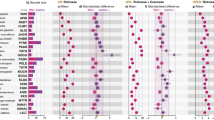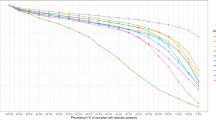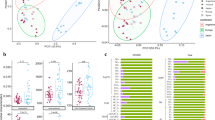Abstract
A wealth of human studies have demonstrated the importance of gut microbiota to health. Research on non-human animal gut microbiota is now increasing, but what insight does it provide? We reviewed 650 publications from this burgeoning field (2009–2016) and determined that animals driving this research were predominantly ‘domestic’ (48.2%), followed by ‘model’ (37.5%), with least studies on ‘wild’ (14.3%) animals. Domestic studies largely experimentally perturbed microbiota (81.8%) and studied mammals (47.9%), often to improve animal productivity. Perturbation was also frequently applied to model animals (87.7%), mainly mammals (88.1%), for forward translation of outcomes to human health. In contrast, wild animals largely characterised natural, unperturbed microbiota (79.6%), particularly in pest or pathogen vectoring insects (42.5%). We used network analyses to compare the research foci of each animal group: ‘diet’ was the main focus in all three, but to different ends: to enhance animal production (domestic), to study non-infectious diseases (model), or to understand microbiota composition (wild). Network metrics quantified model animal studies as the most interdisciplinary, while wild animals incorporated the fewest disciplines. Overall, animal studies, especially model and domestic, cover a broad array of research. Wild animals, however, are the least investigated, but offer under-exploited opportunities to study ‘real-life’ microbiota.
Similar content being viewed by others
Log in or create a free account to read this content
Gain free access to this article, as well as selected content from this journal and more on nature.com
or
References
Ahmed HA, Sirohi SK, Dagar SS, Puniya AK, Singh N . (2014). Effect of supplementation of Selenomonas ruminantium NDRI-PAPB 4 as direct fed microbial on rumen microbial population in Karan Fries male calves. Indian J Anim Nutr 31: 20–26.
Amato KR . (2013). Co-evolution in context: The importance of studying gut microbiomes in wild animals. Microbiome Sci Med 1: 10–29.
Boissière A, Tchioffo MT, Bachar D, Abate L, Marie A, Nsango SE et al. (2012). Midgut microbiota of the malaria mosquito vector Anopheles gambiae and interactions with Plasmodium falciparum infection. PLoS Pathog 8: e1002742.
Bright M, Bulgheresi S . (2010). A complex journey: transmission of microbial symbionts. Nat Rev Microbiol 8: 218–230.
Brinkman BM, Hildebrand F, Kubica M, Goosens D, Del Favero J, Declercq W et al. (2011). Caspase deficiency alters the murine gut microbiome. Cell Death Dis 2: e220.
Carvalho BM, Guadagnini D, Tsukumo DML, Schenka AA, Latuf-Filho P, Vassallo J et al. (2012). Modulation of gut microbiota by antibiotics improves insulin signalling in high-fat fed mice. Diabetologia 55: 2823–2834.
Chandler JA, Lang JM, Bhatnagar S, Eisen JA, Kopp A . (2011). Bacterial communities of diverse Drosophila species: ecological context of a host–microbe model system. PLoS Genet 7: e1002272.
Claesson MJ, Jeffery IB, Conde S, Power SE, O’Connor EM, Cusack S et al. (2012). Gut microbiota composition correlates with diet and health in the elderly. Nature 488: 178–184.
Csardi G, Nepusz T . (2006). The igraph software package for complex network research. Int J Complex Syst 1695: 1–9.
Delsuc F, Metcalf JL, Wegener Parfrey L, Song SJ, González A, Knight R . (2014). Convergence of gut microbiomes in myrmecophagous mammals. Mol Ecol 23: 1301–1317.
Devine AA, Gonzalez A, Speck KE, Knight R, Helmrath M, Lund PK et al. (2013). Impact of ileocecal resection and concomitant antibiotics on the microbiome of the murine jejunum and colon. PLoS ONE 8: e73140.
Dong Y, Manfredini F, Dimopoulos G . (2009). Implication of the mosquito midgut microbiota in the defense against malaria parasites. PLoS Pathog 5: e1000423.
Engel P, Martinson VG, Moran NA . (2012). Functional diversity within the simple gut microbiota of the honey bee. Proc Natl Acad Sci USA 109: 11002–11007.
Esposito D, Damsud T, Wilson M, Grace MH, Strauch R, Li X et al. (2015). Black currant anthocyanins attenuate weight gain and improve glucose metabolism in diet-induced obese mice with intact, but not disrupted, gut microbiome. J Agric Food Chem 63: 6172–6180.
Fenton A, Viney ME, Lello J . (2010). Detecting interspecific macroparasite interactions from ecological data: patterns and process. Ecol Lett 13: 606–615.
Fisher RA . (1937) The Design of Experiments. 2nd ednOliver and Boyd: London, UK.
Garner JP . (2014). The significance of meaning: why do over 90% of behavioral neuroscience results fail to translate to humans, and what can we do to fix it? ILAR J 55: 438–456.
Gilbert JA, Jansson JK, Knight R . (2014). The Earth Microbiome project: successes and aspirations. BMC Biol 12: 69.
Gordon JI . (2012). Honor thy gut symbionts redux. Science 336: 1251–1253.
Glendinning L, Nausch N, Free A, Taylor DW, Mutapi F . (2014). The microbiota and helminths: sharing the same niche in the human host. Parasitology 141: 1255–1271.
Hoseinifar SH, Sharifian M, Vesaghi MJ, Khalili M, Esteban MÁ . (2014). The effects of dietary xylooligosaccharide on mucosal parameters, intestinal microbiota and morphology and growth performance of Caspian white fish (Rutilus frisii kutum fry. Fish Shellfish Immunol 39: 231–236.
Hufeldt MR, Nielsen DS, Vogensen FK, Midtvedt T, Hansen AK . (2010). Variation in the gut microbiota of laboratory mice is related to both genetic and environmental factors. Comp Med 60: 336–347.
Jones KE, Patel NG, Levy MA, Storeygard A, Balk D, Gittleman JL et al. (2008). Global trends in emerging infectious diseases. Nature 451: 990–993.
Khachatryan ZA, Ktsoyan ZA, Manukyan GP, Kelly D, Ghazaryan KA, Aminov RI . (2008). Predominant role of host genetics in controlling the composition of gut microbiota. PLoS ONE 3: e3064.
Kohl KD, Dearing MD . (2014). Wild-caught rodents retain a majority of their natural gut microbiota upon entrance into captivity. Environ Microbiol Rep 6: 191–195.
Kreisinger J, Bastien G, Hauffe HC, Marchesi J, Perkins SE . (2015). Interactions between multiple helminths and the gut microbiota in wild rodents. Philos Trans R Soc Lond B Biol Sci 370: 20140295.
Le Floc’h N, Knudsen C, Gidenne T, Montagne L, Merlot E, Zemb O . (2014). Impact of feed restriction on health, digestion and faecal microbiota of growing pigs housed in good or poor hygiene conditions. Animal 8: 1632–1642.
Leydesdorff L . (2007). Betweenness centrality as an indicator of the interdisciplinarity of scientific journals. J Assoc Inf Sci Technol 58: 1303–1319.
Li Q, Zhang Q, Wang C, Tang C, Zhang Y, Li N et al. (2011). Fish oil enhances recovery of intestinal microbiota and epithelial integrity in chronic rejection of intestinal transplant. PLoS ONE 6: e20460.
Lozupone CA, Stombaugh JI, Gordon JI, Jansson JK, Knight R . (2012). Diversity, stability and resilience of the human gut microbiota. Nature 489: 220–230.
Marchesi JR, Ravel J . (2015). The vocabulary of microbiome research: a proposal. Microbiome 3: 31.
Maurice CF, Knowles SC, Ladau J, Pollard KS, Fenton A, Pedersen AB et al. (2015). Marked seasonal variation in the wild mouse gut microbiota. ISME J 9: 2423–2434.
McGuire AL, Colgrove J, Whitney SN, Diaz CM, Bustillos D, Versalovic J . (2008). Ethical, legal, and social considerations in conducting the Human Microbiome Project. Genome Res 18: 1861–1864.
Nelson TM, Rogers TL, Carlini AR, Brown MV . (2013). Diet and phylogeny shape the gut microbiota of Antarctic seals: a comparison of wild and captive animals. Environ Microbiol 15: 1132–1145.
Nguyen TLA, Vieira-Silva S, Liston A, Raes J . (2015). How informative is the mouse for human gut microbiota research? Dis Model Mech 8: 1–16.
Ogilvie LA, Jones BV . (2015). The human gut virome: a multifaceted majority. Front Microbiol 6: 918.
Paine RT . (1966). Food web complexity and species diversity. Am Nat 100: 65–75.
Pedersen AB, Babayan SA . (2011). Wild immunology. Mol Ecol 20: 872–880.
Pédron T, Mulet C, Dauga C, Frangeul L, Chervaux C, Grompone G et al. (2012). A crypt-specific core microbiota resides in the mouse colon. mBio 3: e00116–12.
Peterson J, Garges S, Giovanni M, McInnes P, Wang L, Schloss JA et al. (2009). The NIH Human Microbiome Project. Genome Res 19: 2317–2323.
Phillips ML . (2009). Gut reaction: environmental effects on the human microbiota. Environ Health Perspect 117: A198–A205.
Prajapati B, Rajput P, Jena PK, Seshadri S . (2015). Investigation of chitosan for prevention of diabetic progression through gut microbiota alteration in sugar rich diet induced diabetic rats. Curr Pharm Biotechnol 17: 173–184.
Ren Z, Cui G, Lu H, Chen X, Jiang J, Liu H et al. (2013). Liver ischemic preconditioning (IPC) improves intestinal microbiota following liver transplantation in rats through 16 s rDNA-based analysis of microbial structure shift. PLoS ONE 8: e75950.
Roggenbuck M, Sauer C, Poulsen M, Bertelsen MF, Sørensen SJ . (2014). The giraffe (Giraffa camelopardalis rumen microbiome. FEMS Microbiol Ecol 90: 237–246.
Round JL, Mazmanian SK . (2009). The gut microbiota shapes intestinal immune responses during health and disease. Nat Rev Immunol 9: 313–323.
Schloss PD, Delalibera I, Handelsman J, Raffa KF . (2006). Bacteria associated with the guts of two wood-boring beetles: Anoplophora glabripennis and Saperda vestita (Cerambycidae). Environ Entomol 35: 625–629.
Spor A, Koren O, Ley R . (2011). Unravelling the effects of the environment and host genotype on the gut microbiome. Nat Rev Microbiol 9: 279–290.
Stevenson TJ, Buck CL, Duddleston KN . (2014). Temporal dynamics of the cecal gut microbiota of juvenile arctic ground squirrels: a strong litter effect across the first active season. Appl Environ Microbiol 80: 4260–4268.
Thakar J, Pathak AK, Murphy L, Albert R, Cattadori IM . (2012). Network model of immune responses reveals key effectors to single and co-infection dynamics by a respiratory bacterium and a gastrointestinal helminth. PLoS Comput Biol 8: e1002345.
Tun HM, Mauroo NF, Yuen CS, Ho JCW, Wong MT, Leung FC-C . (2014). Microbial diversity and evidence of novel homoacetogens in the gut of both geriatric and adult giant pandas (Ailuropoda melanoleuca. PLoS ONE 9: e79902.
Xenoulis PG, Gray PL, Brightsmith D, Palculict B, Hoppes S, Steiner JM et al. (2010). Molecular characterization of the cloacal microbiota of wild and captive parrots. Vet Microbiol 146: 320–325.
Xie Y, Chen H, Zhu B, Qin N, Chen Y, Li Z et al. (2014). Effect of intestinal microbiota alteration on hepatic damage in rats with acute rejection after liver transplantation. Microb Ecol 68: 871–880.
Zeng B, Yuan J, Li W, Tang H, Wei H . (2012). The effect of artificial rearing on gut microbiota in a mouse pup-in-a-cup model. Exp Anim 61: 453–460.
Acknowledgements
This research is supported by the Autonomous Province of Trento under the ‘Trentino programme of research, training and mobility of post-doctoral researchers’ Incoming Team project ECOBIOME (EU FP7 Marie Curie actions COFUND: 2011 Call). We thank the Fondazione E Mach and Cardiff University for facilities, and J Lello and the anonymous reviewers for useful comments on the manuscript.
Author information
Authors and Affiliations
Corresponding author
Ethics declarations
Competing interests
The authors declare no conflict of interest.
Additional information
Supplementary Information accompanies this paper on The ISME Journal website
Supplementary information
Rights and permissions
About this article
Cite this article
Pascoe, E., Hauffe, H., Marchesi, J. et al. Network analysis of gut microbiota literature: an overview of the research landscape in non-human animal studies. ISME J 11, 2644–2651 (2017). https://doi.org/10.1038/ismej.2017.133
Received:
Revised:
Accepted:
Published:
Issue date:
DOI: https://doi.org/10.1038/ismej.2017.133
This article is cited by
-
Long-Read Sequencing Revealing the Effectiveness of Captive Breeding Strategy for Improving the Gut Microbiota of Spotted Seal (Phoca largha)
Marine Biotechnology (2025)
-
Pondering Ponds: Exploring Correlations Between Cloacal Microbiota and Blood Metabolome in Freshwater Turtles
Microbial Ecology (2025)
-
Uncovering the gut microbiome and antibiotic resistome of mammals on the Tibetan Plateau
Science China Life Sciences (2025)
-
Stochastic Assembly Increases the Complexity and Stability of Shrimp Gut Microbiota During Aquaculture Progression
Marine Biotechnology (2024)
-
Host species and habitat shape fish-associated bacterial communities: phylosymbiosis between fish and their microbiome
Microbiome (2023)



